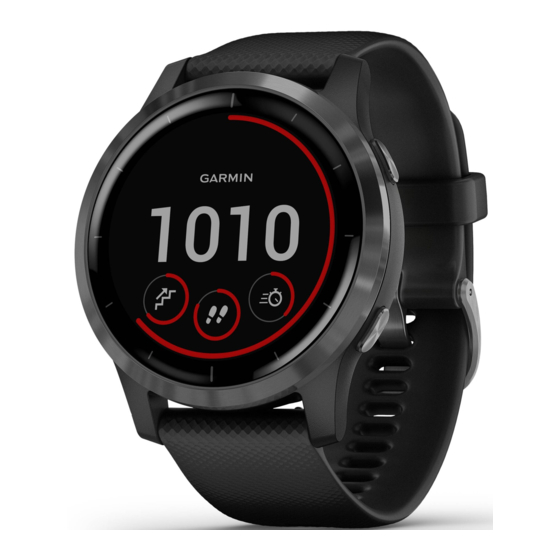Garmin Vivoactive 4S Manuale d'uso - Pagina 13
Sfoglia online o scarica il pdf Manuale d'uso per Guarda Garmin Vivoactive 4S. Garmin Vivoactive 4S 38.
Anche per Garmin Vivoactive 4S: Manuale d'uso (29 pagine)

vívoactive device and view it on paired Garmin devices.
For example, you can broadcast your heart rate data to
an Edge
device while cycling.
®
NOTE: Broadcasting heart rate data decreases battery
life.
1 Hold
.
2 Select
> Wrist Heart Rate.
3 Select an option:
• Select Broadcast In Activity to broadcast heart
rate data during timed activities
Activity,
page 13).
• Select Broadcast to start broadcasting heart
rate data now.
4 Pair your vívoactive device with your Garmin ANT+
compatible device.
NOTE: The pairing instructions differ for each
Garmin compatible device. See your owner's
manual.
Turning Off the Wrist-based Heart Rate Monitor
The default value for the Wrist Heart Rate setting is
Auto. The device automatically uses the wrist-based
heart rate monitor unless you pair a chest heart rate
monitor to the device. Chest heart rate data is only
available during an activity.
NOTE: Disabling the wrist-based heart rate monitor
also disables your VO2 max. estimate, intensity
minutes, the all-day stress feature, and the wrist-based
pulse oximeter sensor.
NOTE: Disabling the wrist-based heart rate monitor
also disables the on-wrist detection feature for Garmin
Pay payments, and you must enter a passcode before
making each payment
(Garmin Pay,
1 Hold
.
2 Select
> Wrist Heart Rate > Status > Off.
About Heart Rate Zones
Many athletes use heart rate zones to measure and
increase their cardiovascular strength and improve
their level of fitness. A heart rate zone is a set range of
heartbeats per minute. The five commonly accepted
heart rate zones are numbered from 1 to 5 according
to increasing intensity. Generally, heart rate zones are
calculated based on percentages of your maximum
heart rate.
Setting Your Heart Rate Zones
The device uses your user profile information from the
initial setup to determine your default heart rate zones.
The device has separate heart rate zones for running
and cycling. For the most accurate calorie data during
your activity, you should set your maximum heart
rate. You can also set each heart rate zone. You can
manually adjust your zones on the device or using your
Garmin Connect account.
1 Hold
.
8
(Starting an
page 5).
2 Select
> User Profile > Heart Rate Zones.
3 Select Default to view the default values (optional).
The default values can be applied to running and
cycling.
4 Select Running or Cycling.
5 Select Preference > Set Custom.
6 Select Max� HR, and enter your maximum heart
rate.
7 Select a zone, and enter a value for each zone.
Heart Rate Zone Calculations
% of
Zone
Maximum
Heart Rate
1
50–60%
Relaxed, easy
pace, rhythmic
breathing
2
60–70%
Comfortable
pace, slightly
deeper
breathing,
conversation
possible
3
70–80%
Moderate
pace, more
difficult to hold
conversation
4
80–90%
Fast pace
and a bit
uncomfortable,
breathing
forceful
5
90–100% Sprinting pace,
unsustainable
for long period
of time, labored
breathing
About VO2 Max� Estimates
VO2 max. is the maximum volume of oxygen (in
milliliters) you can consume per minute per kilogram
of body weight at your maximum performance. In
simple terms, VO2 max. is an indication of athletic
performance and should increase as your level of
fitness improves.
On the device, your VO2 max. estimate appears as a
number and description.
On your Garmin Connect account, you can view
additional details about your VO2 max. estimate,
including your fitness age. Your fitness age gives
you an idea of how your fitness compares with a
person of the same gender and different age. As you
exercise, your fitness age can decrease over time.
Perceived
Benefits
Exertion
Beginning-level
aerobic training,
reduces stress
Basic
cardiovascular
training, good
recovery pace
Improved
aerobic
capacity,
optimal
cardiovascular
training
Improved
anaerobic
capacity and
threshold,
improved speed
Anaerobic
and muscular
endurance,
increased power
Heart Rate Features
